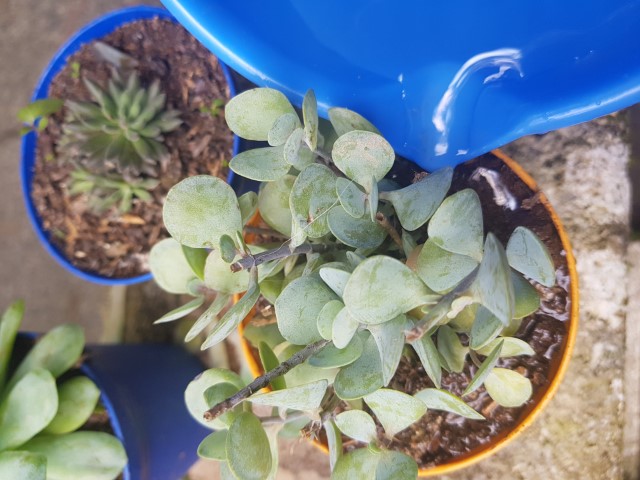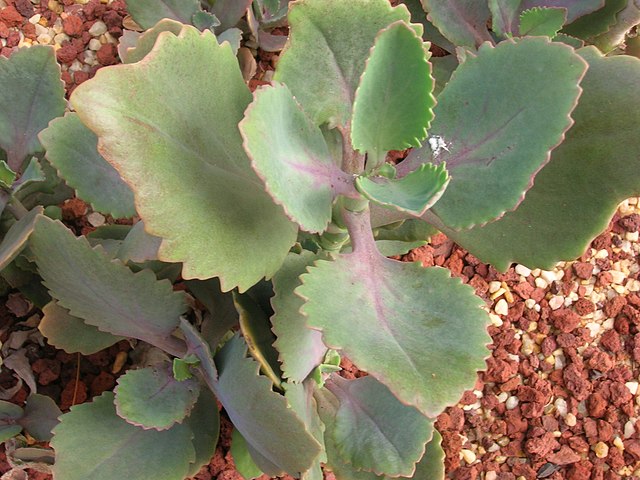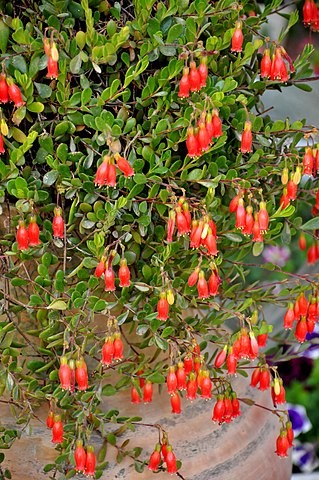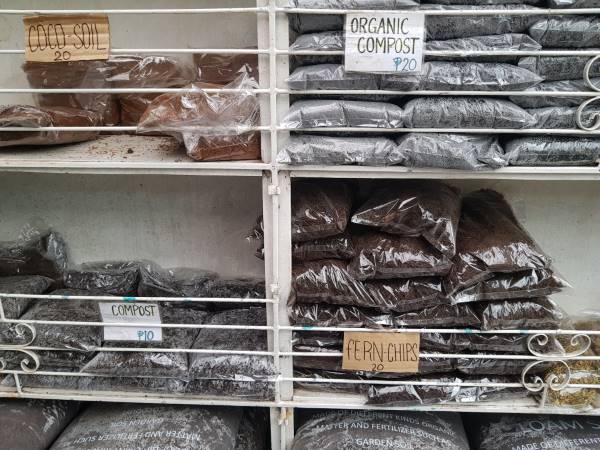Kalanchoes are amazing succulents, which are very popular for their attractive foliage and ease of care. The most promising feature of these succulents is their ability to store water in the fleshy leaves and stems, which enables them to thrive well in drought and water-scarce conditions for a prolonged period.
It is so interesting to note that instead of a complex root zone that absorbs water for the plants, they store all water in the stems and leaves.
Kalanchoes are very specific for their water needs and require moderate watering. They can’t tolerate overwatering and underwatering.
Generally, underwatering doesn’t make a big problem in most cases, but overwatering is the always most troublesome situation. Therefore, you must not give excess water to your Kalanchoe succulents in any case, because they can’t stand overwatering at all.
How do you know if a Kalanchoe is over watered or under watered?
By looking at the general appearance of the succulent, it is hard to make an idea if it is overwatered or underwatered. To distinguish between overwatered and underwatered Kalanchoes, try to read the signs more closely.
A close examination of the leaves can help to determine whether a Kalanchoe is overwatered or underwatered. In both cases, the leaves will show different symptoms.
Leaves that appear soft, translucent, and mushy are the consequence of overwatering. The underwatered Kalanchoes will have wrinkled and shriveled leaves. These are the most obvious symptoms of underwatering and overwatering.
However, mostly overwatered and underwatered Kalanchoes resemble each other, and it becomes very hard to read the signs and distinguish between them. The similarity between both mostly leads to confusion and misdiagnosis. An incorrect diagnosis can lead to wrong treatment and ultimately you may end up killing your succulents.
Through this article, we’ll help you to learn all the signs of overwatering and underwatering. Once you master reading these signs, you can easily tell if a succulent is overwatered or underwatered.
Over watered Kalanchoes
Kalanchoes don’t require watering frequently. If you keep over-watering your succulents their leaves will swell by absorbing additional water and ultimately burst.
Signs of an over watered Kalanchoe succulent
An overwatered Kalanchoe succulent will display several signs.
Keep reading to learn the signs of overwatering.
- Leaves will turn soft and mushy
An overwatered Kalanchoe will have mushy leaves that will turn soft and squishy. This is the telltale sign that you are giving excess water to your succulents more than what they need. - Translucent leaves
An overwatered Kalanchoe will start losing the normal green color of the leaves. The leaves will gradually lose all the green color and become translucent. - Rotting of leaves
Kalanchoe succulents will start rotting from the bottom towards the crown portion. All leaves of the plant will rot and turn black. - Overwatering encourages fungal growth
An overwatered Kalanchoe will succumb to fungal growth and turn black. Fungal infection is usually favored by the excess of moisture. Fungal growth will appear on the roots and foliar parts of the plants. - Dropping of leaves
If you keep overwatering your succulents, they will start dropping the leaves. Usually, the leaves at the bottom will be affected first. The leaves will become swollen and weak. Once they swell up, even a slight touch of your hand can cause the dropping of leaves. - The overall sickly appearance of Kalanchoes
An overwatered Kalanchoe succulent will give a sick appearance and can be quite easily distinguished from a healthy plant. The succulents will appear sick in any of the two situations,
If they are potted in a poorly draining growth medium
If they are oversaturated with water
In some cases, you may observe that you are giving moderate watering to your Kalanchoes but still they are showing the typical signs of overwatering. It may be due to the following reasons
You are not giving enough time to the soil for drying out before applying the next water.
The potting medium has poor drainage. You may be using a growth medium which is too clayey. Calibrate the amount of water you are giving to your succulent, don’t leave the soil too soggy.
A few useful tips to avoid over watering succulents
What should I do to avoid over watering?
- Give moderate water to your succulents. Generally watering once a week is recommended.
- Let the soil drain completely before the next watering.
- Always let the top 1-2 inches of the soil to dry completely.
- Use a well-draining potting medium.
- Use containers with better drainage capacity.
- If your Kalanchoe succulents start displaying the signs of overwatering, immediately cut short the water supply.
Under watered Kalanchoe succulents
Kalanchoes don’t need regular watering and can tolerate a considerable period of drought. In some cases, they can thrive without water for several weeks. But that doesn’t mean that they don’t need water at all.
If you will keep your succulents thirsty for water for a very long period they will die after some time.
How long a Kalanchoe succulent can survive without water?
There is not a fixed time for how long a Kalanchoe can survive without water. It depends on several factors such as temperature, weather, and the potting medium.
Signs of an Under watered Kalanchoe succulent
Here are a few signs you must look for in an underwatered succulent.
- Shriveled and wrinkled leaves
An underwatered Kalanchoe will display shriveled and wrinkled leaves.
Note: Be careful, you might confuse an underwatered Kalanchoe with an overwatered Kalanchoe because the soft mushy leaves of an overwatered succulent can also become shriveled. - Drying of leaves
A prolonged period of dryness will deplete all the water from the plant parts. The leaves will gradually lose the stored water and dry up completely. The drying usually starts from the leaf margins or tips.
The leaves at the bottom of the plant are the first to dry out. This process continues and slowly moves upward until all the leaves dry out completely. - Leaves turn brown
The normal green pigment will slowly disappear from the leaves and they will turn brown after losing all the stored water. - Soft and Flat leaves
Another sign of an underwatered succulent is that the leaves will turn soft, flat, and weak. The normal thick green leaves will appear deflated. The succulents will no longer have healthy, plump, and firm leaves. - Leaf drop
Like overwatered Kalanchoes, underwatered Kalanchoes will also show leaf dropping. This can confuse you between overwatered and underwatered Kalanchoe succulents.
Remember that an overwatered succulent will drop the leaves by even a gentle touch, this is not the same in the case of underwatered Kalanchoes, they will drop the leaves at from the bottom first.
Note: Keep in mind, leaf drop might not be necessarily a sign of underwatering or overwatering. Succulents drop their leaves naturally for water conservation and storage to ensure their survival in the next growing season.
Under watered Kalanchoes will ultimately die
A prolonged period of drought will cause complete drying of the Kalanchoes and they will ultimately die. Once the succulent loses all the water that is necessary to carry out their normal body functions, they will no longer be able to sustain themselves.
You will observe the wilting of succulents with a severe leaf drop. In the end, you will be left with a completely shriveled “Skeleton Succulent”.
A few other signs of under watering
You may also observe some other signs of underwatering.
No flower production, The Kalanchoes will no longer produce any flowers
Hindered growth, once a succulent ceases its normal metabolic activity its growth will be hindered.
What is the difference between an over watered and under watered Kalanchoe succulents?
You might get confused in making a correct identification due to similar signs of overwatering and underwatering. The correct diagnosis is necessary to provide better care to your plants.
Both overwatered and underwatered Kalanchoes will display color variations and lose their turgidity. These signs can not be clearly distinguished at a first glance.
There are a few differences that you must know, to avoid the confusion between the sign of overwatering and underwatering succulent.
- Observe the color variations in your succulents. An overwatered Kalanchoe will change its color rapidly, while an underwatered Kalanchoe changes its color steadily.
- An overwatered Kalanchoe leaf will first become yellow. After gradually losing all the color it will appear translucent. Whereas an underwatered succulent will have dried leaves which will turn light brown or yellowish-brown at the tips.
- An overwatered succulent will show flaccid leaves, and the leaves will be so saturated with water and appear squishy. The internal structure of overwatered Kalanchoes will be destroyed completely. An underwatered succulent will also show flaccid leaves, but its internal structure and tissues will not be destroyed, and they will remain intact.
Some useful tips to avoid underwatering Succulent
Give moderate watering to your plants. Don’t leave them without water for a long time. It is recommended to water your Kalanchoes as soon as the soil dries out.
Don’t keep your plants at a very dry or heated place for long, it will cause a rapid loss of water.
Bottom Line
Water is essential to carry out the normal metabolic activity of the succulents. Give your Kalanchoes moderate watering, to sustain the physiological functions and healthy growth.
Excess and shortage of water both are damaging to the health of Kalanchoe succulents. Keep a close eye on your succulents, for timely diagnosis and to save them from any potential damage.
Have a great gardening experience!





